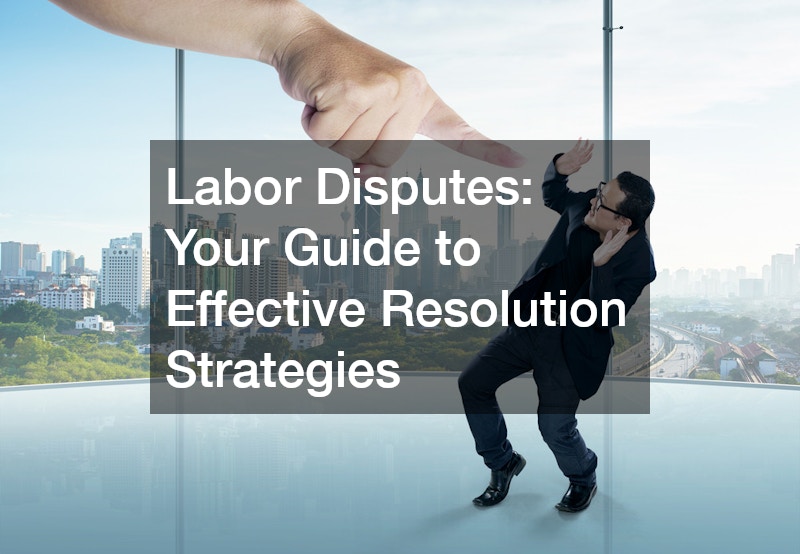Labor Disputes: Your Guide to Effective Resolution Strategies

Labor disputes are a common challenge in the workplace, arising from disagreements between employers and employees. Resolving these disputes effectively is important to maintain a harmonious work environment and ensure fair treatment for all parties involved. This guide explores several key strategies for addressing labor disputes, each with its own set of advantages and potential drawbacks.
Negotiation: Direct Dialogue for Mutual Agreement
Negotiation is often the first step in resolving a labor dispute. This method involves direct discussions between the employer and the employee, aiming to reach a mutual agreement.
Negotiation allows both parties to present their perspectives and work collaboratively toward a solution that satisfies both sides. One of the primary benefits of negotiation is its flexibility—parties can explore creative solutions tailored to their specific needs. However, negotiation can sometimes be time-consuming and may not always lead to a resolution if the parties cannot find common ground.
Mediation: Facilitated Resolution with a Neutral Third Party
Mediation involves bringing in a neutral third party to help facilitate a resolution between the disputing parties. The mediator’s role is to guide the discussion, encourage open communication, and help both sides explore potential solutions. Unlike arbitration, mediation does not involve making binding decisions but instead focuses on helping the parties reach a voluntary agreement. Mediation can be beneficial because it often leads to faster resolutions than litigation and allows for more creative and mutually satisfactory solutions. However, the success of mediation largely depends on the willingness of both parties to engage constructively.
Arbitration: Binding Decisions by an Arbitrator
Arbitration is a method where an arbitrator makes a binding decision after hearing both sides of the dispute. This process is more formal than mediation and is similar to a court proceeding, although it is generally less rigid. The arbitrator’s decision is final and legally binding, which can provide a definitive resolution to the dispute. Arbitration can be advantageous due to its structured process and the finality of the decision. However, it may lack the flexibility of negotiation and mediation, and parties may find themselves constrained by the arbitrator’s ruling.
For those seeking a structured resolution with the assurance of expertise and impartiality, exploring judicial arbitration and mediation services can be beneficial. These services offer professional guidance and can help determine the best approach for resolving your specific dispute effectively.
Collective Bargaining: Negotiating with Groups
Collective bargaining is a key method for resolving labor disputes when dealing with a group of employees, typically represented by a union. This approach involves negotiations between the employer and the union to address issues such as wages, working conditions, and benefits. Collective bargaining can be effective in ensuring that the needs and concerns of a large group of employees are addressed comprehensively. It also provides a structured framework for negotiations, which can lead to more organized and predictable outcomes. However, collective bargaining can be complex and time-consuming, and reaching an agreement may be challenging if there are significant differences between the parties.
Litigation: Court-Based Resolution
In some cases, labor disputes may escalate to litigation, where the matter is taken to court for a legal resolution. Litigation involves a formal legal process where a judge or jury makes a decision based on the evidence presented. While litigation can provide a clear and legally enforceable resolution, it is often the most time-consuming and costly option. Additionally, litigation can strain relationships between employers and employees, making it less ideal for disputes where ongoing collaboration is necessary.
Grievance Procedures: Formal Company Processes
Many organizations have established grievance procedures outlined in employment contracts or company policies. These formal processes provide a structured way for employees to raise concerns and seek resolution. Grievance procedures often involve multiple stages, including filing a complaint, conducting investigations, and providing an opportunity for appeal. These procedures can be effective in ensuring that disputes are handled consistently and fairly according to established guidelines. However, they can sometimes be rigid and may not always address the underlying issues to the satisfaction of both parties.
In Closing
Understanding the various strategies for resolving labor disputes is essential for employers and employees alike. Each method—negotiation, mediation, arbitration, collective bargaining, litigation, and grievance procedures—has its own strengths and limitations. The choice of method often depends on the nature of the dispute, the relationship between the parties, and the desired outcome. By exploring these options, parties involved in labor disputes can select the most appropriate approach to achieve a fair and effective resolution.
.




